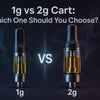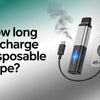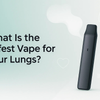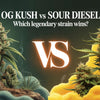How Much Does a Disposable Vape Cost in 2025
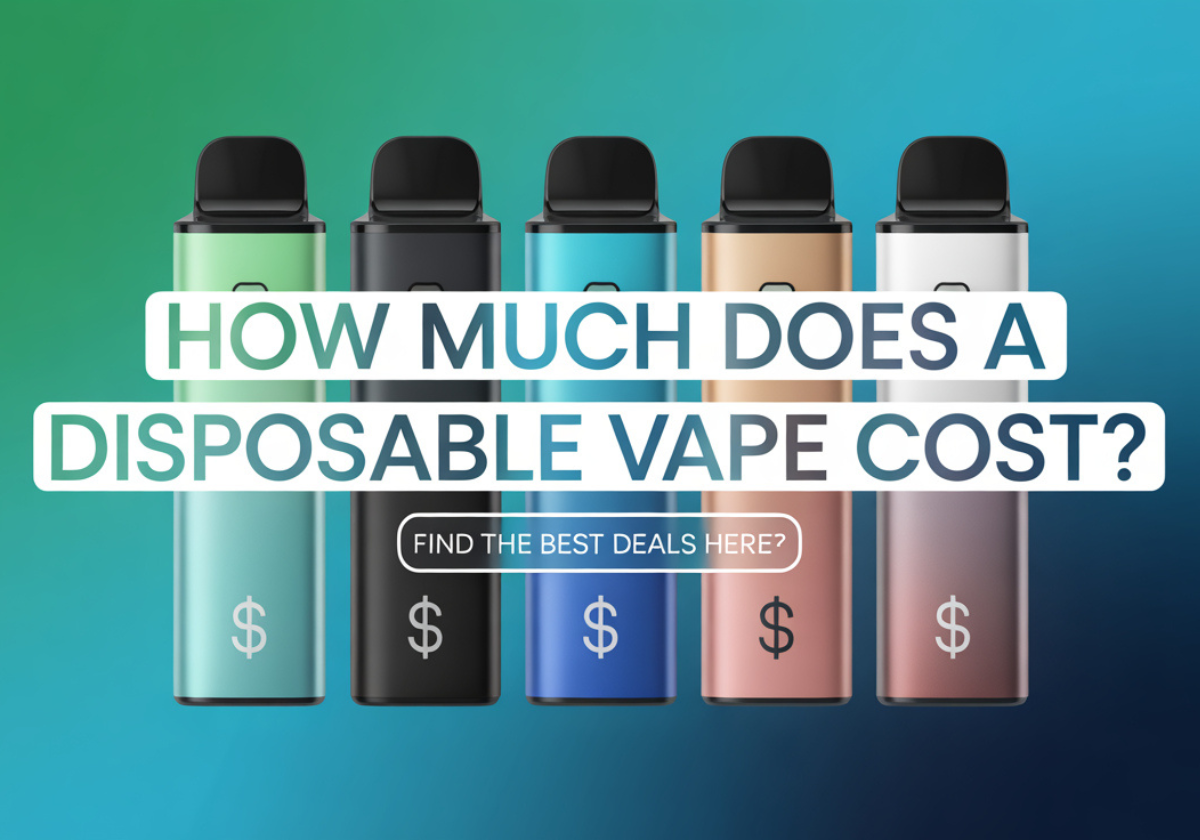
How Much Does a Disposable Vape Cost?
Vaping has exploded in popularity thanks to its convenience and perceived affordability compared to traditional smoking. Whether you're considering making the switch from cigarettes or you're already a vaper looking to explore new options, one question keeps popping up "how much does a disposable vape cost?"
The short answer? Most disposable vapes range from $8 to $25, with the average falling around $12-15 for a standard device. However, the real story behind vape pricing is much more nuanced. Your final cost depends on factors like brand reputation, puff count, nicotine strength, and where you shop.
In this comprehensive guide, we'll break down everything you need to know about disposable vape costs, compare different price points, and help you make an informed decision that fits your budget and vaping needs.
Top Disposable Vapes: A Price Comparison
Understanding the disposable vape market requires looking beyond just price tags. Each brand occupies a specific niche, offering different value propositions that justify their positioning. Let's explore what you're actually getting for your money across different price tiers.
Premium Brands: Where Quality Meets Performance
Delta King
Delta King has rapidly established itself as a premium player in the disposable vape market through their commitment to exceptional quality and innovative features. These devices immediately stand out with their sophisticated design aesthetic – clean lines, premium materials, and thoughtful color schemes that appeal to discerning users who view their vape as both a functional device and a style statement, whether they’re enjoying a classic flavor or exploring strains like a smooth blue dream vape.
What truly sets Delta King apart is their advanced airflow technology and superior coil engineering. Each device delivers remarkably consistent vapor production from first puff to last, with no degradation in flavor intensity or throat hit satisfaction. Their nicotine salt formulation is perfectly balanced, providing smooth delivery without harshness, making them particularly appealing to users transitioning from traditional cigarettes or those who appreciate refined vaping experiences. For those who enjoy variety, options like a Hybrid Cart can complement the experience, offering balanced effects alongside Delta King’s signature performance.
The flavor profiles demonstrate Delta King's commitment to authenticity and complexity. Whether you're enjoying their signature fruit blends or exploring their innovative dessert-inspired options, each flavor is crafted with premium ingredients that avoid the artificial aftertaste common in lower-tier products. The devices also feature enhanced leak-resistance and improved battery efficiency, ensuring reliable performance throughout their extended lifespan.

Elf Bar
Elf Bar has earned its reputation as the gold standard of disposable vapes through relentless focus on consistency and user experience. When you pick up an Elf Bar, you immediately notice the solid construction – there's no rattling or cheap plastic feel that plagues budget alternatives. The draw activation is incredibly responsive, delivering smooth, satisfying vapor from the first puff to the last, whether you’re enjoying a classic flavor or exploring strains like a pineapple express vape for a tropical twist.
What sets Elf Bar apart is their flavor mastery. Whether you're enjoying their signature Blue Razz Lemonade or exploring newer additions like Strawberry Ice Cream, each flavor profile is carefully crafted to avoid the artificial aftertaste common in cheaper devices. Their nicotine salt formulation provides a throat hit that closely mimics traditional cigarettes, making them particularly popular among people transitioning from smoking. How much does a vape pen usually cost in this premium category reflects the extensive research and development that goes into each device.
Geek Bar
Geek Bar represents the pinnacle of disposable vape engineering. Their devices feel substantial in your hand – not chunky, but with a reassuring weight that suggests quality components inside. The mesh coil technology they employ creates exceptionally smooth vapor production with enhanced flavor intensity that remains consistent throughout the device's lifespan.
The brand's attention to detail extends to their packaging and design aesthetics. Each Geek Bar features a sleek, modern appearance with clear strain identification and nicotine strength labeling. Their advanced airflow system prevents the harsh, burnt taste that can occur with cheaper devices as they near depletion. Much like sativa carts that balance style with uplifting performance, Geek Bar appeals to users who appreciate both function and design, where the premium pricing reflects genuine technological advancement.
Lost Mary
Lost Mary occupies the sweet spot where premium quality meets accessible pricing. These devices showcase innovative flavor combinations you won't find elsewhere – think Watermelon Ice mixed with subtle mint undertones, their popular Lemon Sparkling Wine that actually captures the complexity of the real beverage, or even classics that fans of strains like grandaddy purple vape will appreciate for their rich, smooth profiles.
The ergonomic design deserves special mention. Lost Mary devices are shaped to fit comfortably in your palm with a slightly curved body that feels natural during extended use. The mouthpiece is carefully contoured to provide an optimal seal without being too tight or too loose. This attention to user comfort, combined with reliable performance, makes them a favorite among daily vapers who value both form and function.
Mid-Range Brands: Balancing Value and Reliability
Hyde
Hyde has built a loyal following by consistently delivering reliable performance at a reasonable price point. These devices represent honest value – you won't find cutting-edge features or revolutionary design, but you will get a dependable vaping experience that lasts as long as advertised.
The flavor selection strikes a good balance between popular classics and unique offerings. Their tobacco and menthol variants are particularly well-regarded among former smokers, providing authentic taste profiles without the complexity of premium brands. Hyde devices feature a simple, no-nonsense design that prioritizes functionality over flashiness, making them ideal for users who want effective vaping without paying for premium aesthetics, much like a 1g cart that delivers straightforward performance without unnecessary extras.
Puff Bar Plus
As one of the pioneers in the disposable vape market, Puff Bar Plus maintains its relevance through brand recognition and consistent quality control. While their puff counts are lower than newer competitors, the reliability factor makes them a safe choice for new vapers or those who prefer to try different flavors frequently. For users who enjoy the simplicity of dispo carts, Puff Bar Plus continues to deliver a dependable and flavorful vaping experience.
The compact size makes Puff Bar Plus devices extremely portable – they slip easily into a shirt pocket or small purse without creating bulk. The draw resistance is calibrated to provide a cigarette-like experience, which explains their continued popularity among people transitioning from traditional tobacco products. The nicotine delivery remains steady throughout the device's lifespan, avoiding the weakening effect common in budget alternatives, much like the consistent performance enthusiasts expect from a well-crafted indica cart.
Budget Options: Basic Performance at Entry-Level Prices
Pop Disposables
Pop Disposables serve as an excellent entry point for vaping newcomers or occasional users who don't want to invest heavily upfront. While you won't get the sophisticated flavor profiles of premium brands, the basic fruit and menthol options are pleasant and authentic enough for casual use, much like delta vapes that focus on simplicity and accessibility.
The construction is noticeably simpler – lightweight plastic housing and basic coil systems – but the devices function reliably within their intended scope. They're perfect for social situations, travel, or as backup devices for regular vapers. The lower puff count actually works as an advantage for people who want to control their consumption or try multiple flavors, such as a king vape, without committing to larger devices.
Mojo
At the ultra-budget end of the market, Mojo devices prioritize affordability above all else. These compact units offer basic functionality for users who want to experience vaping without any significant financial commitment. While the flavor selection is limited and the vapor production modest, they serve their purpose as an introduction to vaping or as an emergency backup option.
The small size and minimal design make them incredibly discreet – perfect for users who prefer subtle vaping in social situations. Despite the budget pricing, Mojo maintains basic safety standards and consistent nicotine delivery, though the overall experience lacks the refinement of higher-priced alternatives.
How much does a disposable vape cost at a gas station versus other retailers? Gas stations typically charge 20-40% more than online retailers, with convenience stores falling somewhere in between. How much is a disposable vape at a smoke shop usually offers more competitive pricing than gas stations, often matching or beating online prices.
Which Factors Typically Influence the Price of Disposable Vapes?
Understanding what drives vape pricing helps you make smarter purchasing decisions and recognize genuine value versus marketing hype. The disposable vape market operates on several key cost factors that directly impact your final purchase price.
Brand Reputation
Brand reputation functions as the invisible premium you pay for peace of mind and consistent quality. Established brands like Juul, Elf Bar, and Geek Bar command higher prices not just because of marketing, but due to years of investment in research and development, rigorous quality control processes, and extensive safety testing.
When you purchase a recognized brand, you're paying for their track record of reliability. These companies have built sophisticated supply chains, maintain consistent manufacturing standards, and often provide better customer support when issues arise. The same applies to Delta 8 vapes — how much a Juul or Elf Bar costs reflects this accumulated trust and the company's ongoing investment in product improvement.
Lesser-known brands may offer similar specifications at lower prices, but they often lack the quality assurance infrastructure that prevents batch-to-batch variations. The premium you pay for established brands essentially buys you predictability – you know what to expect from your purchase.
Nicotine Strength and Formulation
The type and concentration of nicotine significantly impacts production costs and, consequently, retail pricing. Traditional freebase nicotine is relatively inexpensive to source and process, but most modern disposables use nicotine salts, which require more sophisticated manufacturing processes.
Nicotine salt formulations involve combining nicotine with benzoic acid or other organic acids to create a smoother, more bioavailable form of nicotine. This chemical process requires specialized equipment, higher-grade raw materials, and more stringent quality control measures. The result is a superior user experience with faster nicotine absorption and reduced throat irritation, but these benefits come at increased production costs.
How much does a vape with nicotine cost compared to nicotine-free alternatives? Typically $2-4 more due to several factors: ingredient costs (nicotine salts are more expensive than basic flavorings), regulatory compliance requirements (nicotine products face stricter testing and documentation requirements), specialized storage and handling during manufacturing, and additional quality control measures to ensure consistent nicotine delivery.
Devices with higher nicotine concentrations (35-50mg) often cost slightly more than lower strength options (20-25mg) due to the additional raw material costs and the need for more precise manufacturing tolerances to ensure safety and consistency.
Flavor Variety and Quality
Flavor development represents one of the most significant cost differentials in disposable vape manufacturing. Creating authentic, appealing flavors requires expensive food-grade flavor extracts, extensive testing to achieve the right balance, and ongoing refinement based on user feedback.
Premium brands invest heavily in flavor chemistry, often employing dedicated flavor specialists and conducting extensive consumer testing. Complex flavors like "Strawberry Kiwi Ice" or "Vanilla Custard Tobacco" require multiple flavor compounds that must be perfectly balanced to avoid off-notes or flavor separation over time. These sophisticated profiles can add $1-3 to manufacturing costs compared to simple single-note flavors.
Budget brands often use simpler, more generic flavor compounds that may taste artificial or fade quickly as the device ages. The difference becomes apparent in longer sessions – premium flavors maintain their integrity throughout the device's lifespan, while cheaper alternatives may develop harsh or muted taste profiles as they near depletion.
Quality flavoring also affects the overall vaping experience through factors like vapor production, throat hit smoothness, and aftertaste. Premium flavor formulations are designed to work synergistically with the device's coil system and airflow design.
Device Quality and Construction
The physical construction of disposable vapes varies dramatically across price points, directly impacting both manufacturing costs and user experience. Premium devices feature multiple quality upgrades that justify their higher pricing.
Housing materials range from basic plastic in budget devices to premium polycarbonate or even metal accents in high-end options. Better materials provide improved durability, better heat dissipation, and a more premium feel in hand. The internal components – circuit boards, wiring, and connectors – also vary significantly in quality and precision.
Leak prevention represents a major quality differentiator. Premium devices employ multiple sealing mechanisms, pressure-tested assemblies, and carefully engineered internal chambers to prevent e-liquid leakage. Budget alternatives often skip these measures to reduce costs, leading to messy leaks and potential device failure.
Airflow systems showcase another quality divide. Premium devices feature precisely machined air channels, adjustable flow controls in some cases, and carefully calibrated draw resistance. These systems require additional manufacturing steps and quality control, but they provide superior vapor production and user satisfaction.

Nicotine Delivery System
The method used to heat and vaporize e-liquid directly impacts both performance and manufacturing costs. This technical aspect often goes unnoticed by users but represents significant cost variations between devices.
Basic wire coils, found in budget disposables, consist of simple resistance wire wrapped around a basic wick material. While functional, they provide inconsistent heating, can produce burnt tastes as they age, and offer limited flavor reproduction. Manufacturing costs are minimal, keeping device prices low.
Mesh coil systems, increasingly common in premium devices, use a fine metal mesh instead of traditional wire coils. This design provides more even heating, better flavor reproduction, and longer-lasting performance. However, mesh coils require more precise manufacturing tolerances and higher-quality materials, adding $2-4 to production costs.
Ceramic heating elements, found in some ultra-premium disposables, offer the best flavor purity and most consistent performance. These systems eliminate the metallic taste that can develop with wire coils and provide extremely even heat distribution. The manufacturing complexity and material costs make them expensive to implement.
The wicking system – how e-liquid reaches the heating element – also varies in sophistication. Premium devices use advanced wicking materials and designs that ensure consistent liquid flow throughout the device's lifespan, preventing dry hits and maintaining flavor consistency.
Puff Count & E-Liquid Capacity
Puff count directly correlates with device size, battery capacity, and e-liquid volume – all major cost drivers in disposable vape manufacturing. Understanding this relationship helps explain the pricing structure across different device categories.
Higher puff counts require larger batteries, which represent a significant portion of manufacturing costs. A device offering 5,000 puffs needs roughly five times the battery capacity of a 1,000-puff device, with costs scaling accordingly. Battery technology, safety circuits, and charging capabilities (in rechargeable disposables) all add to the final price.
E-liquid capacity scales with puff count, but the relationship isn't always linear. Premium devices often use more efficient vaporization systems that extract more puffs from each milliliter of e-liquid. Budget devices may advertise high puff counts but achieve them through less efficient systems that provide weaker vapor production.
The physical size implications also affect costs. Larger devices require more housing material, larger packaging, and higher shipping costs. However, the per-puff cost typically decreases with larger devices, making high-capacity disposables more economical for regular users.
Advanced Features
Modern disposable vapes increasingly incorporate sophisticated features that add both functionality and cost. These additions represent the evolution of disposables from simple, basic devices to sophisticated vaping systems.
LED indicators serve both functional and aesthetic purposes. Basic versions simply show device activation, while advanced systems display battery life, puff count, or even flavor selection. The electronic components and programming required for these features can add $1-3 to manufacturing costs.
Adjustable airflow systems, once exclusive to refillable devices, now appear in premium disposables. These mechanisms allow users to customize their vaping experience from tight, cigarette-like draws to loose, cloud-producing inhales. The precision mechanical components required for reliable airflow adjustment increase both complexity and cost.
Rechargeable capabilities represent a significant technical upgrade. Adding a charging port, battery management circuitry, and the associated safety systems can double the electronic complexity of a disposable device. However, rechargeable disposables often provide better value by allowing users to consume all the e-liquid before disposal.
Digital displays, found in ultra-premium disposables, show real-time information about remaining puffs, battery life, or even vapor temperature. These features require sophisticated electronics and programming, adding $3-5 to manufacturing costs but providing a premium user experience.
Other Factors
Several additional factors contribute to disposable vape pricing that often go unnoticed by consumers but significantly impact final retail costs.
Packaging quality varies dramatically across price points. Premium brands invest in sophisticated packaging with detailed product information, tamper-evident seals, and attractive presentation that enhances the unboxing experience. This packaging serves practical purposes – better protection during shipping and storage – while also supporting brand image.
Regulatory compliance costs affect all nicotine-containing products but impact different brands disproportionately. Established brands often have dedicated regulatory teams and established testing protocols, spreading these costs across large production volumes. Smaller brands may face proportionally higher compliance costs, sometimes reflected in retail pricing.
Distribution and retail markup structures also influence final pricing. Products sold through traditional tobacco retail channels (gas stations, convenience stores) typically carry higher markups than those sold through specialized vape shops or online retailers. Disposable vape price range variations often reflect these distribution differences rather than actual product cost differences.
Geographic factors play a role in regional pricing variations. Local taxes, import duties (for internationally manufactured products), and regional competition levels all influence what consumers pay. Urban markets with higher operating costs for retailers typically see higher prices than rural areas with lower overhead costs.
How Much Does Vaping Cost Per Month?
How much does it cost to vape per month depends heavily on your usage patterns:
Light User (1-2 disposables per month)
- Monthly Cost: $15-35
- Annual Cost: $180-420
- Perfect for social vapers or those transitioning from cigarettes
Moderate User (3-6 disposables per month)
- Monthly Cost: $40-90
- Annual Cost: $480-1,080
- Typical for regular vapers who use their device daily
Heavy User (8-12 disposables per month)
- Monthly Cost: $100-200
- Annual Cost: $1,200-2,400
- Chain vapers or those using lower-puff devices
Cost of refillable vs disposable vape: Refillable systems can reduce monthly costs by 40-60% for heavy users, but require more maintenance and upfront investment.
Is vaping cheaper than smoking cigarettes? A pack-a-day smoker spends roughly $150-300 monthly on cigarettes, making moderate vaping significantly cheaper.
Long-Term Vaping Expenses and Cost-Saving Tips
Long-term vaping expenses can add up, but there are ways to optimize your spending:
- Buy in bulk during sales to reduce per-unit costs
- Compare cost per puff rather than just upfront price
- Consider refillable systems if you're a heavy user
- Track your usage to avoid over-purchasing
- Take advantage of loyalty programs from favorite retailers
High-end vape devices like premium disposables or advanced pod systems cost more upfront but often provide better value through improved efficiency and longer lifespan.
Conclusion
How much does a disposable vape cost? The answer ranges from $8-25 for most users, with $12-15 being the sweet spot for quality and value. Your ideal choice depends on your budget, usage frequency, flavor preferences, and desired features.
What is the average price of a vape across all categories is around $14, but smart shopping can help you find quality options for less. Whether you're looking for cheap disposable vapes vs premium vapes, focus on cost per puff and overall reliability rather than just upfront price.
Remember, how much should I pay for a quality vape depends on your needs. Occasional users can get great value from budget options, while regular vapers benefit from investing in mid-range or premium devices.
Ready to find the perfect disposable vape for your budget? Explore our selection of affordable, high-quality disposable vapes at Delta King and discover why thousands of customers trust us for their vaping needs.
Frequently Asked Questions
How much does a disposable vape cost at a gas station?
Gas station disposable vapes typically cost $10-25, which is 20-40% more than online prices. The convenience factor drives this premium, and selection is usually limited to popular brands like Puff Bar and Hyde.
How much is a disposable vape at a smoke shop compared to online?
Smoke shops usually offer more competitive pricing than gas stations, often matching online prices at $8-20 per device. Many smoke shops also offer bulk discounts and loyalty programs that can reduce costs further.
What is the average price of a disposable vape in the US?
The average price ranges from $12-15 for a standard disposable vape with 1,500-2,500 puffs. Budget options start around $8, while premium brands can cost $20-25.
How much does a vape pen usually cost for beginners?
For beginners, a quality disposable vape costs $10-15, while a refillable vape pen starter kit ranges from $20-40. Disposables are recommended for first-time users due to their simplicity.
Do refillable vapes cost more than disposable vapes?
Initially yes – refillable vapes cost $15-40 upfront plus $10-20 for e-liquid. However, they become cheaper over time, potentially saving heavy users 40-60% monthly compared to disposables.
Why are disposable vapes so expensive compared to cigarettes?
Disposables aren't necessarily more expensive than cigarettes when you calculate cost per use. A $15 disposable with 2,500 puffs equals about 12-15 cigarettes daily for a week, comparable to a pack of cigarettes per day in cost.
How much does it cost to vape per month using disposables?
Light users spend $15-35 monthly, moderate users $40-90, and heavy users $100-200. This depends on puff count preferences and usage frequency.
How much should I pay for a quality disposable vape brand like Elf Bar or Juul?
Elf Bar disposables cost $15-22, while Juul pods are $12-16 per pack (equivalent to disposables). These premium prices reflect consistent quality, safety testing, and reliable performance.
Are cheap disposable vapes worth it or do they run out faster?
Cheap disposables ($6-10) often provide fewer actual puffs than advertised and may have inconsistent flavor or nicotine delivery. Mid-range options ($12-16) typically offer better value and reliability.
How much do vapes usually cost with nicotine vs without nicotine?
Nicotine-containing vapes cost $2-4 more than nicotine-free versions due to ingredient costs and regulatory compliance. Most disposables range $12-18 with nicotine, $8-14 without.

